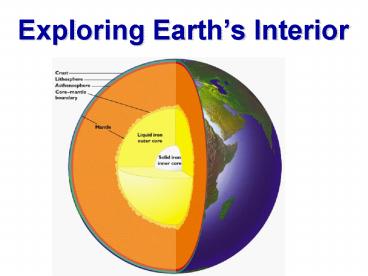Exploring Earths Interior - PowerPoint PPT Presentation
1 / 46
Title:
Exploring Earths Interior
Description:
Self-exciting dynamo. A dynamo produces electric current by moving a conductor in a magnetic field and ... Self-exciting dynamo. The theory has this going for it: ... – PowerPoint PPT presentation
Number of Views:58
Avg rating:3.0/5.0
Title: Exploring Earths Interior
1
Exploring Earths Interior
2
Magnetic Field of the Earth
3
Earth's magnetic field
- The Earth behaves as a magnet whose poles are
nearly coincident with the spin axis (i.e., the
geographic poles). - Magnetic lines of force emanate from the
magnetic poles such that a freely suspended
magnet is inclined upward in the southern
hemisphere, horizontal at the equator, and
downward in the northern hemisphere
4
Earth's magnetic field
- declination horizontal angle between
magnetic N and true N - inclination angle made with horizontal
5
Earth's magnetic field
- It was first thought that the Earth's magnetic
field was caused by a large, permanently
magnetized material deep in the Earth's interior.
- In 1900, Pierre Currie recognized that permanent
magnetism is lost from magnetizable materials at
temperatures from 500 to 700 C (Currie point).
6
Self-exciting dynamo
- A dynamo produces electric current by moving a
conductor in a magnetic field and vise versa.
(i.e., an electric current in a conductor
produces a magnetic field.
7
Self-exciting dynamo
- It is believed that the outer core is in
convective motion (because it is liquid and in a
temperature gradient). - A "stray" magnetic field (probably from the Sun)
interacts with the moving iron in the core to
produce an electric current that is moving about
the Earth's spin axis yielding a magnetic fielda
self-exciting dynamo!
8
Self-exciting dynamo
- The theory has this going for it
- It is plausible.
- It predicts that the magnetic and geographic
poles should be nearly coincident. - The polarity is arbitrary.
- The magnetic poles move slowly.
9
Magnetic reversals
- The polarity of the Earth's magnetic field has
changed thousands of times in the Phanerozoic
(the last reversal was about 700,000 years ago). - These reversals appear to be abrupt (probably
last 1000 years or so).
10
Recording the Magnetic Field in Newly Deposited
Sediment
11
Lavas Recording Reversals in Earths Magnetic
Field
12
The GeomagneticTime Scale
Based on determining the magnetic characteristics
of rocks of known age (from both the oceans and
the continents). We have a good record of
geomagnetic reversals back to about 60 Ma.
13
Formation of Magnetic Anomalies
14
Magnetic Anomalies
15
Age of Seafloor Crust
R. Dietmar Muller, 1997
16
Structure of the Earth
- Seismic velocity depends on the composition of
material and pressure. - We can use the behavior of seismic waves to tell
us about the interior of the Earth. - When waves move from one material to another they
change speed and direction.
17
World Seismicity, 19632000
18
Earthquakes Associated with Divergent and
Transform Margins
19
Earthquakes Associated with Convergent Plate
Margins
20
Comparison of P-wave and S-wave Motion
21
Two Types of Surface Waves
Rayleigh waves
Love waves
22
Seismograph Record of P, PP, S, and Surface Waves
23
Refraction and Reflection of a Beam of Light
Refraction
Reflection
24
P-wave Shadow Zone
25
S-wave Shadow Zone
26
Seismic Velocities
- Vp (K4/3m) / r
- Vs m / r
Where K bulk modulus mshear modulus
27
P-and S-wave Pathways Through Earth
28
Changes in P-and S- wave Velocity Reveal Earths
Internal Layers
29
Structure of the Earth
- Study of the behavior of seismic waves tells
- us about the shape and composition of the
- interior of the Earth
- Crust 1070 km, intermediate composition
- Mantle 2800 km, mafic composition
- Outer core 2200 km, liquid iron
- Inner core 1500 km, solid iron
30
Composition of the Earth
- Seismology tells us about the density
- of rocks
- Continental crust 2.8 g/cm3
- Oceanic crust 3.2 g/cm3
- Asthenosphere 3.3 g/cm3
31
Structure of the Crust and Upper Mantle
32
Earths internal heat
- Original heat
- Subsequent radioactive decay
- Conduction
- Convection
33
Upper Mantle Convection as a Possible Mechanism
for Plate Tectonics
34
Fig. 20.25d
35
Seismic Tomography Scan of a Section of the Mantle
Subducted slab
36
Temperature vs. Depth
37
Examples of Plate Boundaries
O-C convergent
O-O divergent
C-C divergent
O-O divergent
O-O convergent
O-O divergent
O-C convergent
38
Driving mechanism of plate tectonics
- Thought to be convection of the mantle
- Friction at base of the lithosphere transfers
energy from the asthenosphere to the lithosphere. - Convection may have overturned asthenosphere 46
times.
39
(No Transcript)
40
(No Transcript)
41
Examples of Plate Boundaries
O-C convergent
O-O divergent
C-C divergent
O-O divergent
O-O convergent
O-O divergent
O-C convergent
42
Rifting and Seafloor Spreading
43
Spreading Centers Offset by Transform Boundary
44
OceanOcean Convergent Plate Boundary
45
Parts of an OceanContinentConvergent Plate
Boundary
46
Mantle subdivision(b) How do we know what
mantle rocks looks like?(c) What is the mantle
made out of?Evidence?(c) Why does the mantle
melt?































